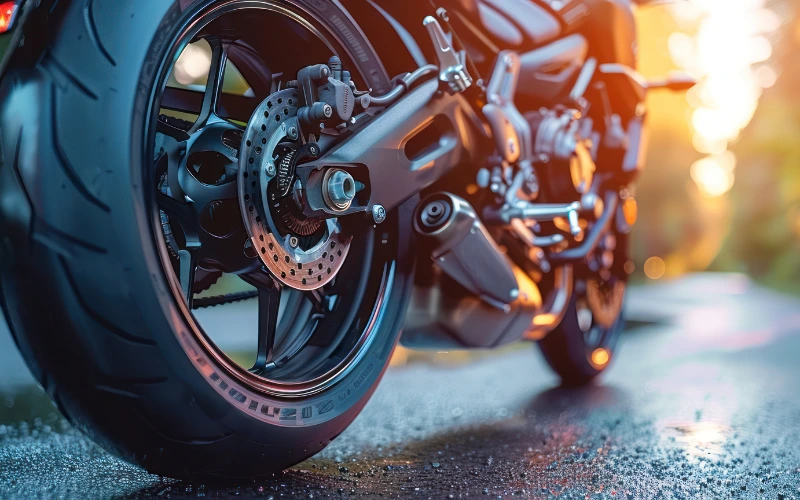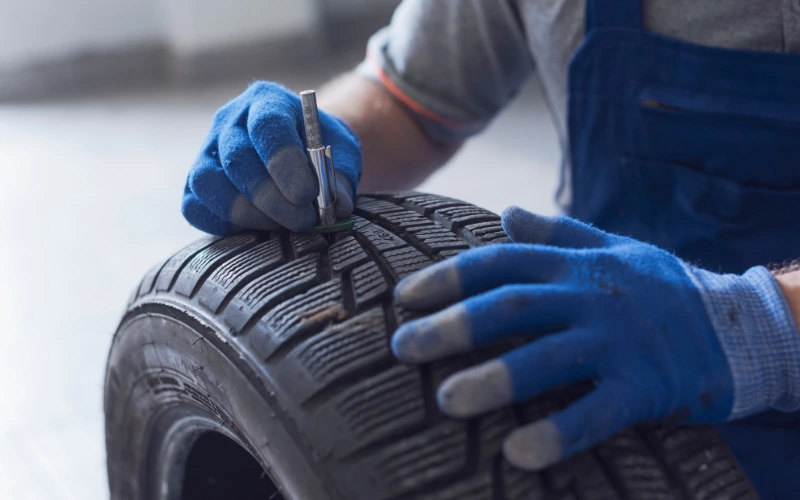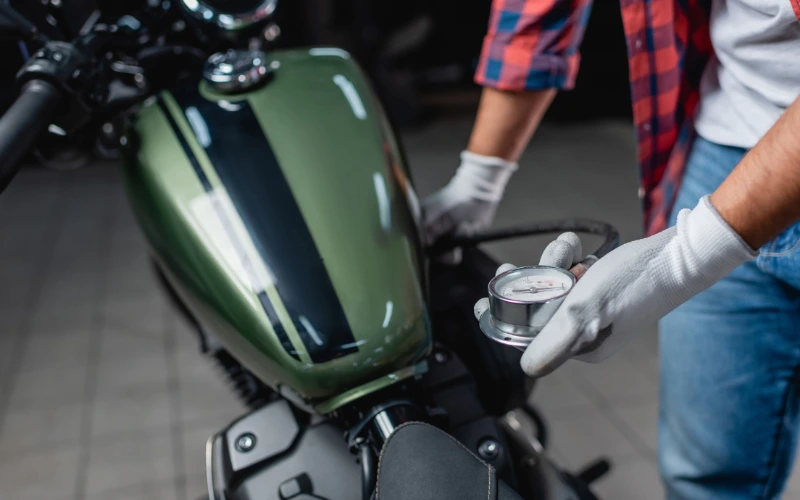How to Check the Tyres on Your Motorcycle
01 Aug 2025

As motorcycle tyres are the only part of the vehicle to touch the ground, they must be in good condition and fit for purpose. Motorbike tyres affect the safety, performance and handling of the vehicle, so it’s important for riders to check them regularly to help spot and resolve any issues early.
In this guide, we explore how to check motorcycle tyres, what to look out for and how to keep them in the best possible condition for longer.
Checking motorcycle tyre tread depth
Every country has individual regulations when it comes to the legal motorcycle minimum tread depth, so it’s important to make yourself familiar with the specific laws where you live or ride. For example, in India, the recommended minimum tread depth is 1.6mm, but in countries like Canada or Norway, your motorcycle’s minimum tread depth should be no less than 3mm in the winter months.
However, it’s also worth noting that this is a legal minimum motorcycle tread depth, not necessarily what is recommended or safest for riding in all types of road and weather conditions.
Many motorcycle tyres have wear indicators included in the tyre design, which sit inside the treads. The idea is that once the tread of the tyre wears down to the same level as the indicator, the tyre needs to be replaced.
However, a more reliable way to check your motorcycle tread depth is with a gauge made for that purpose. You insert the tool into the grooves of the tyre, and it will measure the level of wear with a high degree of accuracy.

What to look out for when checking your motorcycle tyres
Even if motorcycle tyres still have plenty of tread, the rubber can degrade over time and become more likely to cause issues. It’s generally recommended to replace motorcycle tyres, even in good condition, when they are ten years old, at most.
When you are carrying out maintenance checks on your motorcycle tyres, here’s what you should be looking for.
Uneven wear
When checking tyre tread depth, you should test several different areas of the tyre around its whole circumference, as the level of wear can vary in certain parts of the tyre.
Common areas for wear differences can be in the centre of the tyre or on the shoulders. Uneven wear can often be a sign that there might be another issue, such as:
- Under or overinflated tyres: Tyres can wear more in the middle if they are overinflated, and more on the shoulders if they are underinflated.
- ‘Sporty’ driving style: City riding with lots of sudden acceleration or braking can cause uneven wear.
- Unbalanced tyres: If the tyres are out of balance, they can wear unevenly in patches.
- Mechanical issues: Some mechanical problems, such as shock absorbers and suspension not working as they should, can cause uneven tyre wear.
Uneven wear will usually mean you have to replace the tyre sooner, and can make it more difficult to handle the motorcycle on the roads.
Tyre damage
Another important thing to keep an eye on with your motorcycle tyres is to check them visually for any damage. Look out for:
- Damage to the sidewall: Such as any deep scratches, cracks, or any of the tyre tread showing.
- Bulges or lumps in the tyre: This can mean an internal part of the tyre is damaged.
- Surface cracks: This is a sign that the rubber is degrading.
- Flat spots: Badly worn sections of the tyre tread cause the tyre to look deformed or flat.
- Any foreign objects embedded in the tyre: Nails, sharp stones or pieces of glass could cause a puncture.
It’s also important to keep an eye on the age of the tyre. Motorcycle tyres in most countries will have a date stamp on the sidewall to indicate when they were manufactured. You can do an internet search of your tyre numbers to find out when they were made.
Checking your motorcycle tyre pressure

It’s essential to follow the manufacturer’s recommendations when it comes to motorcycle tyre pressure, as it will vary from vehicle to vehicle.
Should your front tyre pressure be the same as the rear tyre?
This can vary depending on the motorcycle model, but it may be recommended that the front and rear motorcycle tyres have a slightly different air pressure. This information will be in the owner’s manual or on a sticker on the vehicle. You can also usually check the manufacturer’s website for confirmation of the optimum tyre pressures for your specific motorcycle.
Step by Step: How to check your motorcycle tyre air pressure
You’ll need a tyre pressure gauge. These are inexpensive to buy, or most fuel stops or petrol stations have tyre air machines you can use for this.
Make sure that your motorcycle is cold (i.e. not been driven recently) and in the shade if the sun is out. This is because heat can cause the tyre pressure to rise and give you inaccurate readings.
-
Find the valve on the inner surface of the wheel rim and remove the cap.
-
Turn on your gauge (if digital) and place it over the valve, pressing firmly until you don’t hear a hiss of air escaping.
-
Read the pressure showing on the gauge.
-
Remove the gauge from the valve and replace the cap.
Adjusting the pressure in motorcycle tyres
If the air in your motorcycle tyres needs to be adjusted, follow these steps:
To increase the air pressure:
Connect an air compressor to your motorcycle’s tyre valve. Most modern tyre air compressors will allow you to set the pressure limit, so the compressor will inflate the tyre to that pressure and then stop, meaning that you can’t overinflate it.
To reduce the air pressure:
If the motorcycle tyre air pressure is too high, you can reduce it by pressing on the valve stem with a small object, such as the edge of the tyre pressure gauge that you just used to check it, or a pen tip. This will cause air to escape. Make sure to keep checking the pressure again so that you don’t reduce it by too much.
Identifying a slow puncture on your motorcycle tyre
If you have noticed that your tyre pressure is lower than it should be every time you check it, even after you have increased it, you may have a slow puncture. Slow punctures increase the risk of having a tyre blowout and can also affect the handling, braking performance and overall stability of the motorcycle.
Other signs of a slow puncture in your motorcycle tyre can include:
- If the motorcycle pulls slightly to the left or right while you’re riding down a straight road.
- Unusual vibration felt through the handlebars, if a slow puncture has caused the wheel to become unbalanced.
- If the handling of the motorcycle noticeably changes, such as the steering feeling different or the suspension feeling harder than usual.
- If one tyre visibly looks flatter than the other when the motorbike is stationary.
- If there is anything sticking into your tyre that shouldn’t be there, such as a nail head.
In some cases, it may be possible for a garage or tyre fitter to fix the tyre with the existing slow puncture so that you don’t need to replace the tyre with a new one, but this will depend on the specific circumstances and how badly the tyre has been damaged.
Maintain a smooth ride
Checking your motorcycle tyres regularly is not only key to safety but can also serve as an early warning sign of other potential issues with your ride. Checking your tyres every week and before longer journeys can help keep you on the road and enjoy top performance from your motorcycle for longer.
If you found this guide useful, find out how our motorcycle lubricants can make a big difference to keeping your motorbike in top condition.

